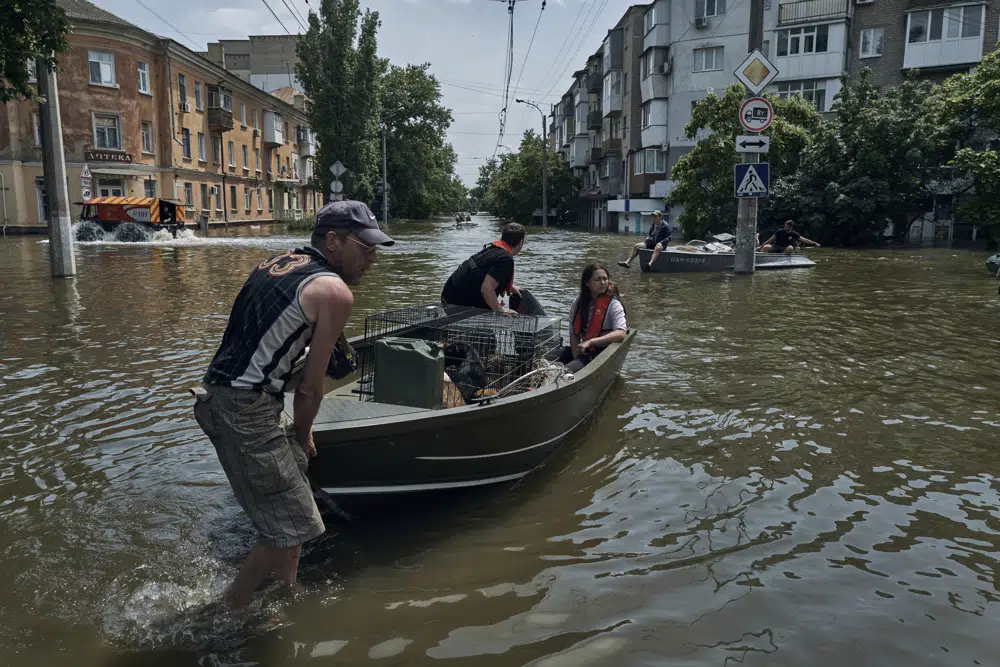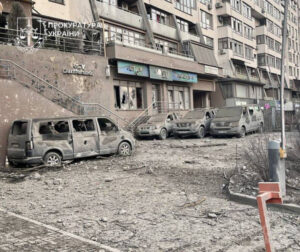Dam collapses and thousands face deluge in Russian-occupied Ukraine

Kyiv, The Gulf Observer: For days, the Ukrainian teenager has waited in the attic, just down the street from the cemetery of her flooded town, marking time with her 83-year-old grandfather and two other elderly people and hoping for help to escape the deluge of a catastrophic dam collapse.
But help is slow in coming to Oleshky, a Russian-occupied town across the Dnieper River from the city of Kherson with a prewar population of 24,000, according to those stranded and their desperate Ukrainian rescuers. Russian forces are taking rescuers’ boats, they say. Some say the soldiers will only help people with Russian passports.
“Russian soldiers are standing at the checkpoints, preventing (rescuers) from approaching the most-affected areas and taking away the boats,” said one volunteer, Yaroslav Vasiliev. “They are afraid of saboteurs, they suspect everyone.”
So 19-year-old Yektarina But and the three elderly people with her simply wait, along with thousands of others believed to be trapped by floodwaters spread across 600 square kilometers (230 square miles) of the Kherson region. About two-thirds of the flooded areas are in territory occupied by Russia, officials said.
The group in the attic have no electricity, no running water, no food. The battery on But’s cellphone is dying.
“We are afraid that no one will know about our deaths,” she said in a brief cellphone interview, her voice trembling.
“Everything around us is flooded,” she said. “There is still no help.” Her grandfather, who had suffered a stroke, was running out of medicine, she said. One woman with her, a neighbor’s grandmother, could not move on her own.
Others have been turned away from rescue.
Viktoria Mironova-Baka said she has been in touch from Germany with relatives stuck in the flooded region.
“My relatives said that Russian soldiers were coming up to the house today by boat, but they said they would only take those with Russian passports,” she told The Associated Press. Her grandmother, aunt and more than a dozen other people are taking shelter in the attic of a two-story house.
Details of life in Russian-occupied Ukraine are often unclear. The AP could not independently verify reports of boat seizures or that only Russians were being evacuated, but the account is in line with reporting by independent Russian media.
It’s a sharp contrast to Ukrainian-controlled territory flooded by the dam collapse. Authorities there have aggressively evacuated civilians and brought in emergency supplies. On Thursday, President Volodymyr Zelenskyy traveled to the area to assess the damage. Russian President Vladimir Putin “has no plans at the current moment” to visit affected Moscow-occupied areas, Kremlin spokesman Dmitry Peskov told journalists.
This region has suffered terribly since Russia invaded Ukraine early last year, enduring sometimes-relentless artillery and missile attacks.
The latest disaster began Tuesday, when the Kakhovka hydroelectric dam, roughly 80 kilometers (50 miles) upstream from Oleshky, collapsed, sending torrents of water down the Dnieper River and across the war’s front lines.
Officials say more than 6,000 people have been evacuated from dozens of inundated cities, towns and villages on both sides of the river. But the true scale of the disaster remains unclear for a region that was once home to tens of thousands of people.
At least 14 people have died in the flooding, many are homeless, and tens of thousands are without drinking water.
The floods ruined crops, displaced land mines, caused widespread environmental damage, and set the stage for long-term electricity shortages.
Ukraine says Russia destroyed the dam with explosives. Russia accuses Ukraine of destroying it with a missile strike.


